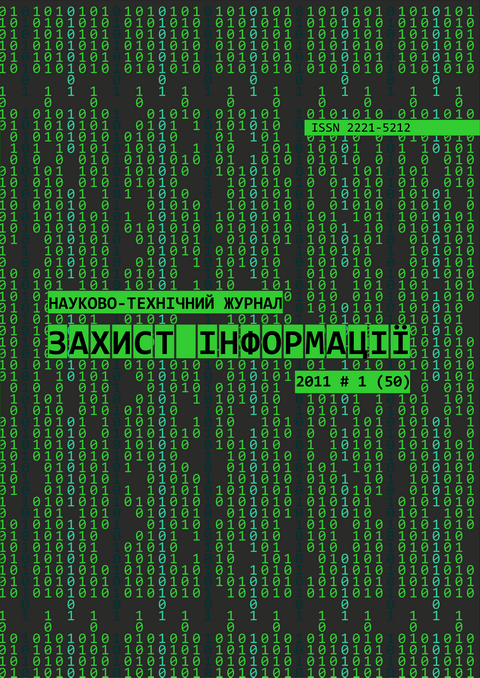СУЧАСНІ СТЕГАНОГРАФІЧНІ МЕТОДИ ЗАХИСТУ ІНФОРМАЦІЇ
DOI:
https://doi.org/10.18372/2410-7840.13.1994Abstract
У роботі представлена систематизація та класифікація сучасних напрямів стеганографії, наведені переваги та недоліки конкретних стеганографічних методів. Виконане дослідження спрямоване на полегшення пошуку існуючих стеганографічних методів та засобів в науковій літературі з метою розробки нових ефективних систем захисту інформації.References
Хорошко В.А. Методы и средства защиты информации / В.А. Хорошко, А.А. Чекатков. – К. : Юниор, 2003. – 464 с.
Грибунин В.Г. Цифровая стеганография / В.Г. Грибунин, И.Н. Оков, И.В. Туринцев; – M : СОЛОН-Пресс, 2002. – 261 с.
Генне О.В. Основные положения стеганографии // Защита информации. Конфидент – 2000. №3 – 56 с.
Жельников В. Криптография от папируса до компьютера / В. Жельников. – М. : ABF, 1997. – С.12-15.
Conway M. Steganography, Signals Intelligence, and Terrorism // Knowledge, Technology and Policy. – 2003. –V.16, №2. – P. 45-47.
Шелков В.A. История "Микроточки" // Журнал "Специальная Техника". – №4/5 – 1999.
Buckland M., Goldberg E. Emanuel Goldberg and His Knowledge Machine. – Libraries Unlimited. – 2006. – 70р.
Смирнов М. Скрытая передача и хранение конфиденциальной информации в Интернете и сотовой связи [Ел. ресурс]. – Режим доступу: http://www.infocity.kiev.ua/hack/content/hack264.phtml.
Барсуков В.С. Компьютерная стеганография вчера, сегодня, завтра. Технологии информационной безопасности 21 века / В.С. Барсуков, А.П. Романцов ; – M : "Специальная Техника", 2007. – 225 с.
Конахович Г.Ф. Компьютерная стеганография. Теория и практика / Г.Ф. Конахович, А.Ю Пузыренко – К.: МК-Пресс, 2006. – 249 с.
An Overview of Steganography for the Computer Forensics Examiner. 2004. [Електронний ресурс]. – Режим доступу: http://www.garykessler.net/library/fsc_stego.html.
The Third International Conference on Vailability, Reliability and Security A Statistical Algorithm for Linguistic Steganography Detection Based on Distribution of Words. [Електронний ресурс]. – Режим доступу:http://www.giac.unibel.by/sm_full.aspx?guid=7933.
Imai H. Quantum Computation and Information. From Theory to Experiment / H. Imai, M. Hayashi – Springer-Verlag: Berlin, Heidelberg. – 2006. – P. 235.
Корченко О.Г., Васіліу Є.В., Гнатюк С.О. Сучасні квантові технології захисту інформації // Науково-технічний журнал "Захист інформації". – 2010, № 1. – С. 77-89.
Bilal A. Shaw. Quantum steganography and quantum error-correction // University of Southern California. –2010. – P.137.
Гомонай О.В. Лекції з квантової інформатики: Навчальний посібник. – Вінниця : О.Власюк. – 2006. – 146с.
Curty M., Santos D.J. Quantum steganography // In 2nd Bielefeld Workshop on Quantum Information andComplexity. – 2000. – P. 12-14.
Ben-Aroya A., Ta-Shma A. On the complexity of approximating the diamond norm – 2009. – V.3. – P. 51-58.
Mogos G. Stego Quantum Algorithm // International Symposium on Computer Science and its Applications. –2008. – P. 187-190.
Teleporting an unknown quantum state via dual classical and Einstein-Podolsky Rosen channels / Bennett C.H.,Brassard G., Crepeau C., Jozsa R., Peres A., Wootters W.K. – 1993. – 128 р.
Bennett C., Wiesner S. Communication via one- and two-particle operators on Einstein-Podolsky-Rosen states. –1992. – V. 69. – P. 2881-2884.
Martin K. Steganographic communication with quantum information / Lecture Notes in Computer Science, –2008. – 130 р.
Downloads
Issue
Section
License
Authors who publish with this journal agree to the following terms:- Authors retain copyright and grant the journal right of first publication with the work simultaneously licensed under a Creative Commons Attribution License that allows others to share the work with an acknowledgement of the work's authorship and initial publication in this journal.
- Authors are able to enter into separate, additional contractual arrangements for the non-exclusive distribution of the journal's published version of the work (e.g., post it to an institutional repository or publish it in a book), with an acknowledgement of its initial publication in this journal.
- Authors are permitted and encouraged to post their work online (e.g., in institutional repositories or on their website) prior to and during the submission process, as it can lead to productive exchanges, as well as earlier and greater citation of published work (See The Effect of Open Access).

